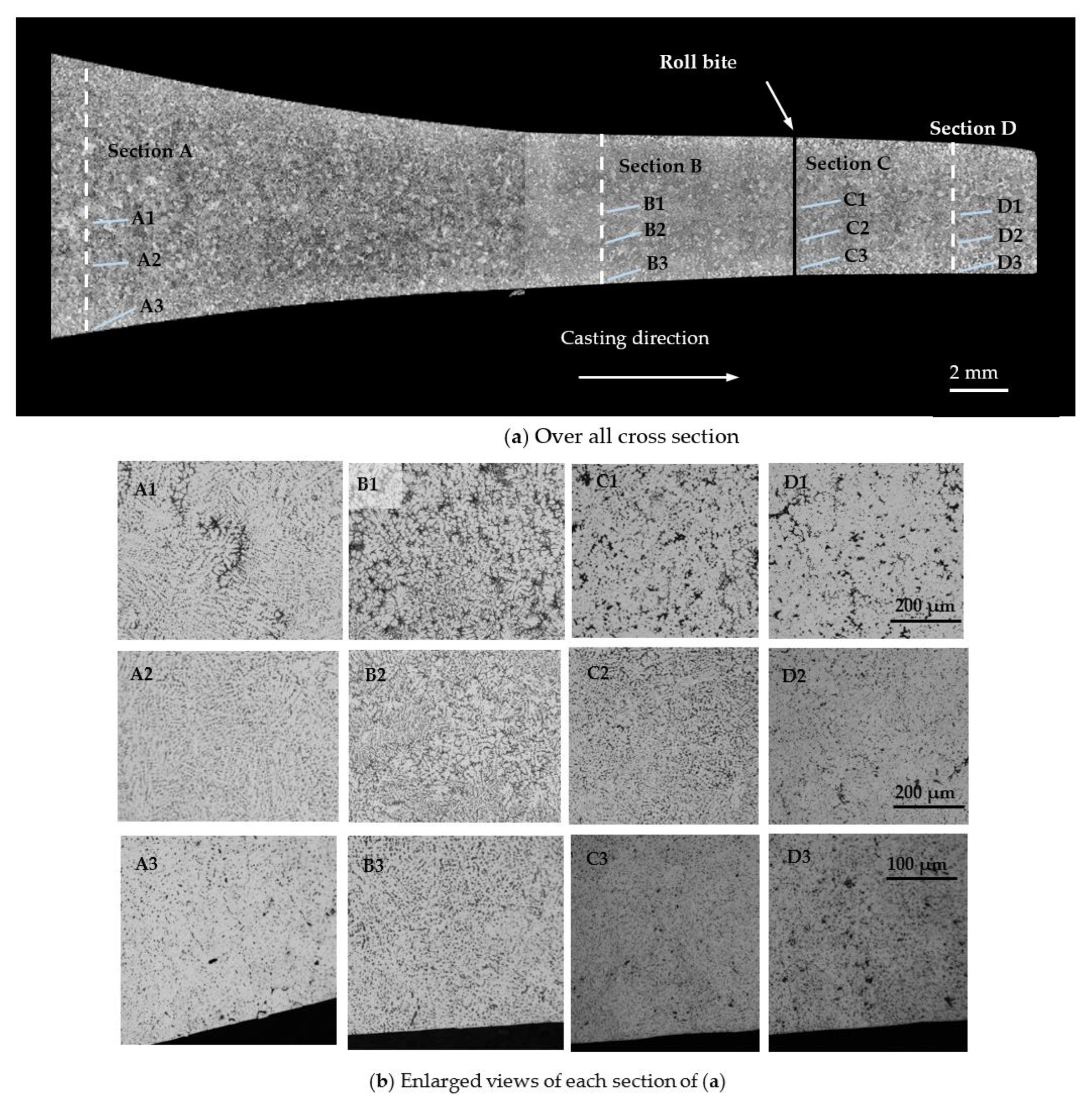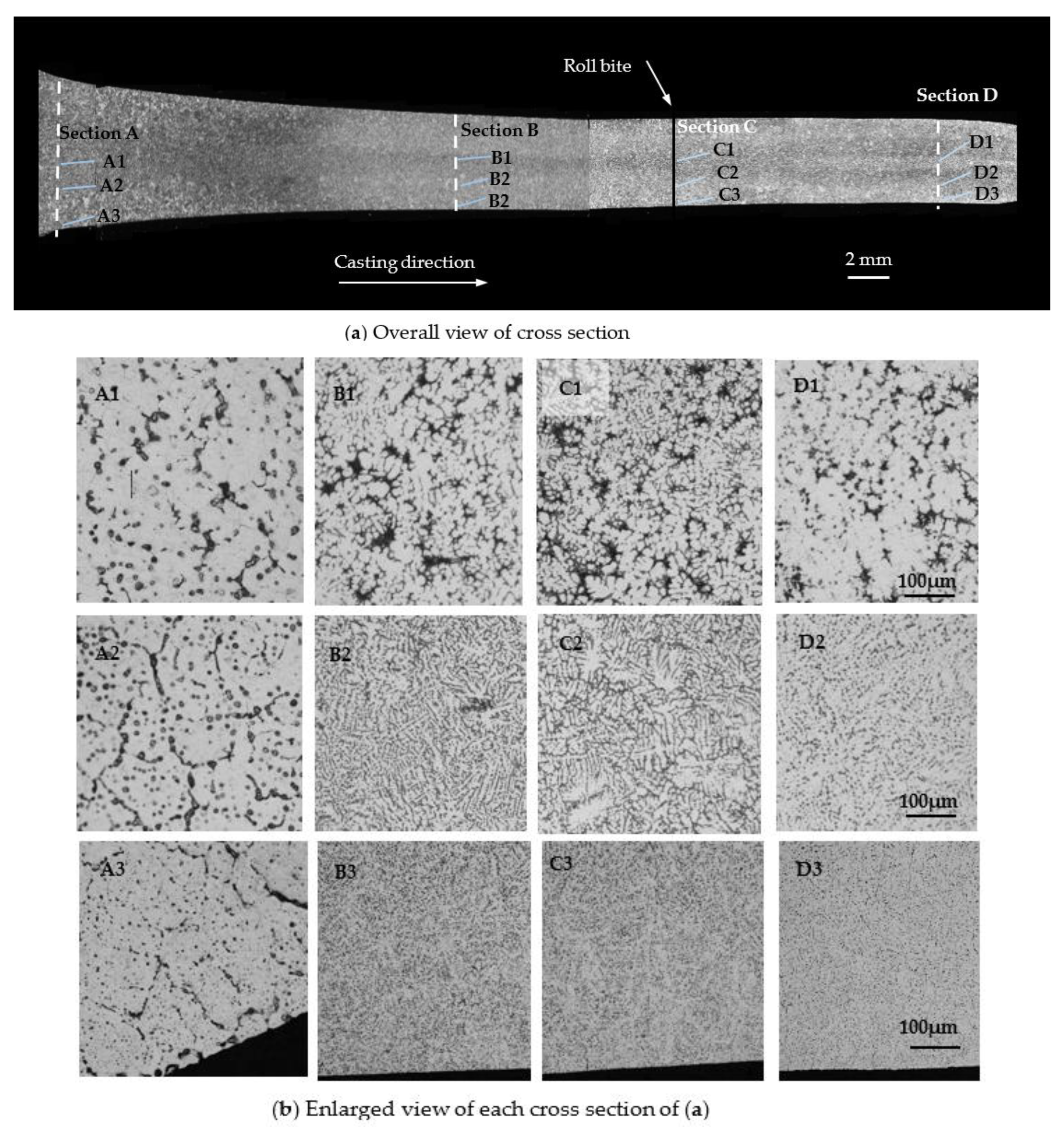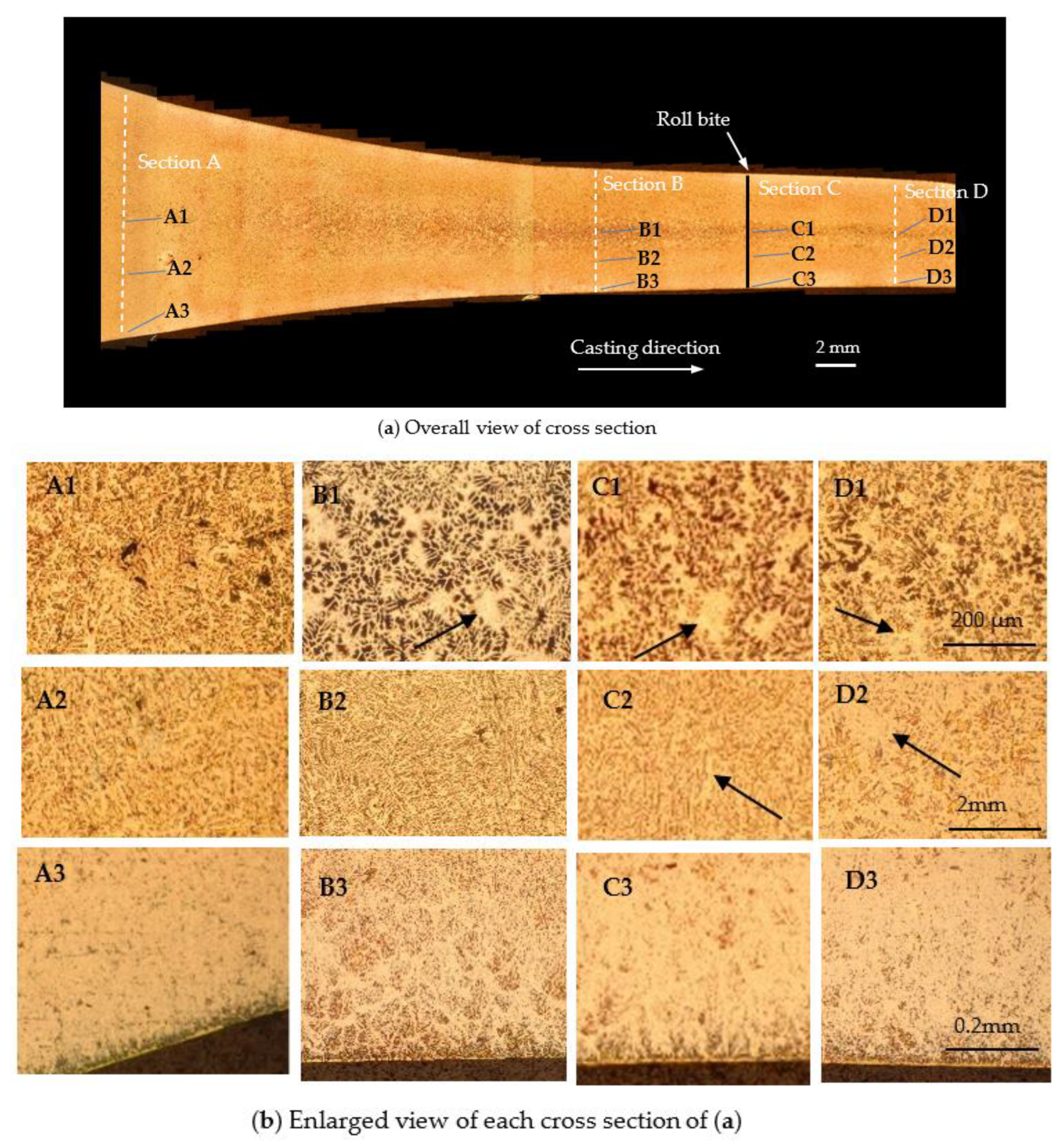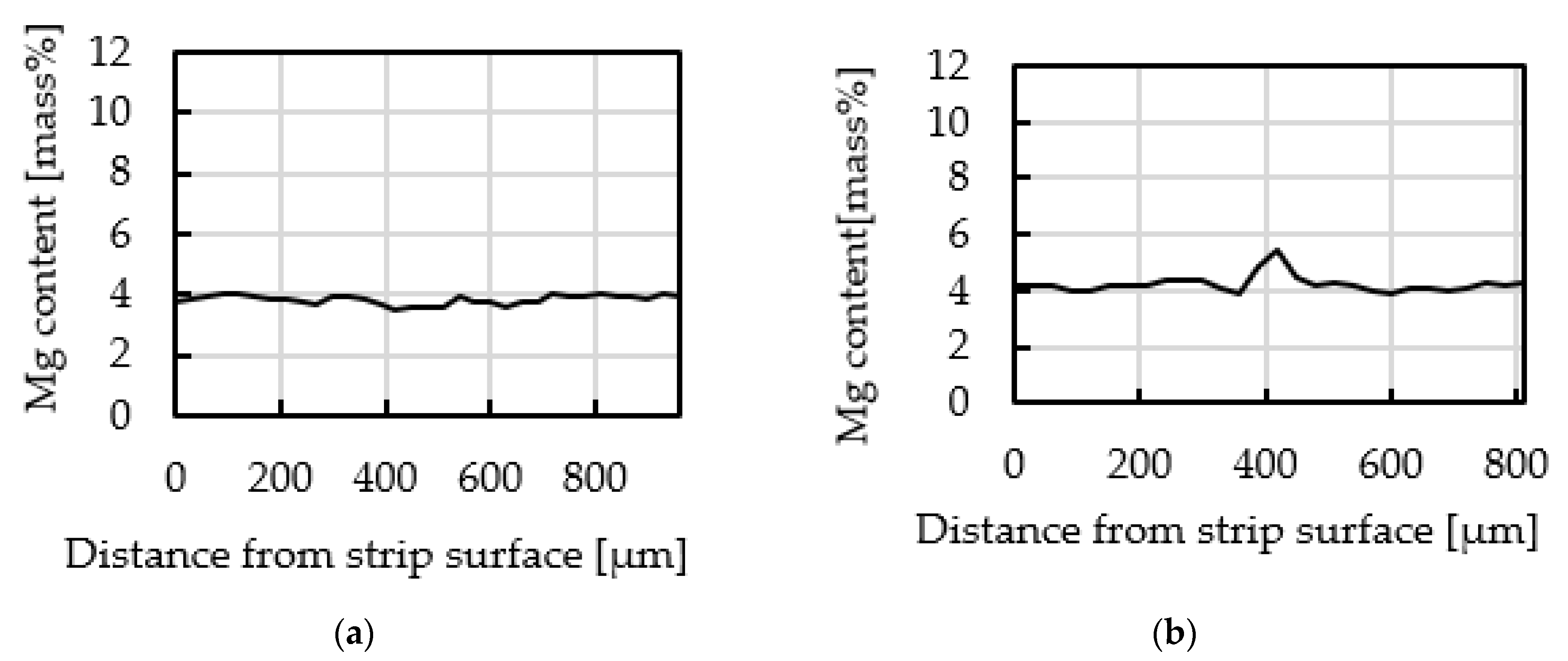High-Speed and Low-Load Twin-Roll Casting of Al–5%Mg Strip
Abstract
:1. Introduction
2. Experimental Conditions
3. Results
3.1. Strip Surface
3.2. Tensile Test
3.3. Microstructure near Roll Bite Obtained by Roll-Stop
3.4. Line Analysis of Mg
4. Discussion
4.1. Tensile Test
4.2. Dendrite Structure
4.3. Mg Distribution
5. Conclusions
- (1)
- When the roll load was 88 N/mm, surface cracking was observed on the as-cast strip, and when the roll load was 2 N/mm, surface cracking was not observed by penetrant testing. The small roll load of 2 N/mm was useful for preventing surface cracking.
- (2)
- Strips cast at roll loads of 2 and 88 N/mm were cold-rolled down to a thickness of 1 mm. Penetrant testing was conducted, and cracking was not observed on the cold-rolled plates. Tensile testing was conducted on annealed 1 mm thick plates. There was almost no difference in tensile strength and elongation in the casting direction between the plates cast at 2 N/mm and 88 N/mm. However, the tensile strength, and especially elongation, in the width direction for strips cast at 88 N/mm was lower than that of strips cast at 2 N/mm. The cause was determined by deep drawing tests, which revealed cracks in the casting direction that were not detected by penetrant testing.
- (3)
- In the cast piece obtained by the roll-stop method, the microstructure changed after the strip exited the roll bite. The microstructure in the band area after exiting the roll bite showed that the microstructure became coarser than that in the roll bite. The microstructure on both sides of the band area had an annealed appearance.
- (4)
- The roll load affected segregation in the band area, judging from the results of a line analysis and etching using Weck’s reagent. When the roll load was 2 N/mm, the band area showed no segregation of Mg, and normal segregation of Mg occurred at edges of the band area. When the roll load was 88 N/mm, the band area showed normal Mg segregation. Segregation in the strip cast at 88 N/mm was greater than that at the edges of the band area of the strip cast at 2 N/mm.
- (5)
- Etching using Weck’s reagent showed that the Mg solution state on both sides of the band area of the strip cast at 88 N/mm was different from that cast at 2 N/mm after the roll bite; in particular, the difference was remarkable near the strip surface. The Mg content near the surface of the strip cast at 2 N/mm was greater than that in the strip cast at 88 N/mm.
- (6)
- When cold rolling and annealing were conducted on as-cast strips, the lack of segregation in the band area for the strip cast at 2 N/mm was eliminated, and normal segregation in the band area of the strip cast at 88 N/mm remained.
- (7)
- It is concluded that the roll load was dominant for forming surface cracks and centerline segregation, and a small roll load of 2 N/mm was very useful for eliminating surface cracks and centerline segregation.
Author Contributions
Funding
Institutional Review Board Statement
Informed Consent Statement
Conflicts of Interest
References
- Cook, R.; Cook, P.G.; Thomas, P.M.; Edmonds, D.V.; Hunt, J.D. Development of the twin-roll casting process. J. Mater. Process. Technol. 1995, 55, 76–84. [Google Scholar] [CrossRef]
- Nussbaum, A.I. Three-state-of-the-art Thin-gage high-speed roll caster for aluminum alloy sheet products Part III. Light Met. Age 1997, 55, 34–39. [Google Scholar]
- Hamer, S.; Romanowski, C.; Taraglio, B. Continuous casting and rolling of aluminum: Analysis of capacities, Product ranges and technology. Light Met. Age 2002, 60, 6–17. [Google Scholar]
- Daaland, O.; Espedal, A.B.; Nedreberg, M.L.; Alvestad, I. Thin gage twin-roll casting, process capabilities and product quality. Light Met. (TMS) 2016, 3, 989–996. [Google Scholar] [CrossRef]
- Li, Y.; He, C.; Li, J.; Wang, Z.; Wu, D.; Xu, G. A novel approach to improve the microstructure and mechanical properties of Al-Mg-Si aluminum alloys during twin-roll casting. Metals 2020, 13, 1713. [Google Scholar] [CrossRef] [Green Version]
- Xu, Z.; Wang, S.; Wang, H.; Song, H.; Li, S.; Chen, X. Effect of cooling rate on Microstructure and properties of twin-roll casting 6061 aluminum alloy sheet. Metals 2020, 10, 1168. [Google Scholar] [CrossRef]
- Haga, T.; Takahashi, K.; Ikawa, M.; Watari, H. A vertical type twin roll caster for aluminum alloy strip. J. Mater. Proc. Technol. 2003, 140, 610–615. [Google Scholar] [CrossRef]
- Haga, T. High Speed Roll Caster for Aluminum Alloy. Metals 2021, 11, 520. [Google Scholar] [CrossRef]
- Haga, T.; Ikawa, M.; Kumai, S. A High-Speed Twin Roll Caster for Aluminum Alloy Thin Strip. Trans.-Mater. Res. Soc. Jpn. 2004, 29, 1823–1828. [Google Scholar]
- Guo, J.; Liu, Y.; Liu, L.; Yang, Q. 3D stress simulation and parameter design during twin-roll casting of 304 stainless steel based on Anand model. Int. J. Miner. Metall. Mater. 2014, 21, 666–673. [Google Scholar] [CrossRef]
- Zan, X.; Liu, L.; Yang, Q. Cracking Possibility Evaluation of 3004 Stainless Steel During Twin Roll Casting by 3D Simulation. J. Mater. Eng. Perform. 2021, 30, 2014–2020. [Google Scholar]
- Choo, D.K.; Moon, H.K.; Kang, T.; Lee, S. Analysis and prevention of cracking during strip casting of AISI 304 stainless steel. Metall. Trans. A 2001, 32, 2249–2258. [Google Scholar] [CrossRef] [Green Version]
- Gras, C.; Meredith, M.; Hunt, J.D. Microstructure formation during the twin-roll casting of Al-Mg-Mn aluminium alloys. J. Mater. Process. Technol. 2005, 67, 62–72. [Google Scholar] [CrossRef]
- Haga, T.; Hirooka, K.; Watari, H.; Kumai, S. Grooved roll for high speed twin roll caster. Arch. Mater. Sci. Eng. 2008, 30, 117–120. [Google Scholar]
- Haga, T.; Okada, T.; Watari, H.; Nishida, S. Effect of Casting Condition on Ripple Mark and Surface Crack of Roll cast Al-Mg Alloy. Key Eng. Mater. 2021, 918, 15–21. [Google Scholar] [CrossRef]
- Haga, T.; Oida, K.; Yamazaki, K.; Watari, H.; Nishida, S. Strip Casting Al-4.7%Mg with Impurity Fe Using a Single Roll Caster with a Scraper. Mater. Sci. Forum 2022, 1073, 115–122. [Google Scholar] [CrossRef]
- Yamazaki, K.; Haga, T. Reduction of Surface Crack by Modified Molten Metal Pouring Method on Al-Mg Alloy Strip Produced by Twin Roll Casting. J. JFS 2022, 94, 282–289. [Google Scholar]
- Harada, Y.; Jiang, N.; Kumai, S. Mechanical Properties of Cold-Rolled and Annealed Al-12%Mg alloy Sheet with High Mg Solid Solubility Fabricated from Vertical-Type High-Speed Twin Roll Cast Strip. Mater. Trans. 2019, 60, 2435–2441. [Google Scholar] [CrossRef]
- Kim, M.S.; Kim, H.E.; Kim, S.H.; Kumai, S. Role of Roll Separating Force in High-Speed Twin-Roll Casting of Aluminum Alloys. Metals 2019, 9, 645. [Google Scholar] [CrossRef] [Green Version]
- Nguyen, T.H.; Song, R.; Harada, Y.; Kumai, S. Color Metallography of Characteristic Microstructure in High-Speed Twin-Roll Cast Al-Mn-Si Alloy Strip Using Weck’s Reagent. Mater. Trans. 2020, 61, 2252–2262. [Google Scholar] [CrossRef]
- Haga, T.; Kurahashi, Y. Effect of Roll Material on Strip Solidification between the Rolls of a Vertical-Type High-Speed Twin-Roll Caster. Metals 2022, 12, 1699. [Google Scholar] [CrossRef]
- Haga, T.; Yamashiki, T.; Watari, H.; Niahida, S. Investigation of Burr on Strips Cast by Vertical-Type High-Speed Twin Roll Caster. Key Eng. Mater. 2020, 831, 40–45. [Google Scholar] [CrossRef]















| Cu | Si | Mg | Zn | Fe | Mn | Ni | Ti | Sn | Cr | Al |
|---|---|---|---|---|---|---|---|---|---|---|
| 0.02 | 0.10 | 4.86 | 0.01 | 0.16 | 0.44 | 0.00 | 0.02 | 0.00 | 0.00 | Bal. |
Disclaimer/Publisher’s Note: The statements, opinions and data contained in all publications are solely those of the individual author(s) and contributor(s) and not of MDPI and/or the editor(s). MDPI and/or the editor(s) disclaim responsibility for any injury to people or property resulting from any ideas, methods, instructions or products referred to in the content. |
© 2022 by the authors. Licensee MDPI, Basel, Switzerland. This article is an open access article distributed under the terms and conditions of the Creative Commons Attribution (CC BY) license (https://creativecommons.org/licenses/by/4.0/).
Share and Cite
Yamazaki, K.; Haga, T. High-Speed and Low-Load Twin-Roll Casting of Al–5%Mg Strip. Metals 2023, 13, 72. https://doi.org/10.3390/met13010072
Yamazaki K, Haga T. High-Speed and Low-Load Twin-Roll Casting of Al–5%Mg Strip. Metals. 2023; 13(1):72. https://doi.org/10.3390/met13010072
Chicago/Turabian StyleYamazaki, Kazuki, and Toshio Haga. 2023. "High-Speed and Low-Load Twin-Roll Casting of Al–5%Mg Strip" Metals 13, no. 1: 72. https://doi.org/10.3390/met13010072





